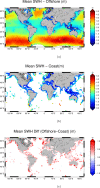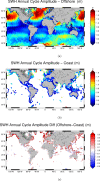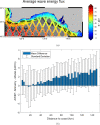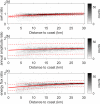Global coastal attenuation of wind-waves observed with radar altimetry
- PMID: 34155219
- PMCID: PMC8217570
- DOI: 10.1038/s41467-021-23982-4
Global coastal attenuation of wind-waves observed with radar altimetry
Abstract
Coastal studies of wave climate and evaluations of wave energy resources are mainly regional and based on the use of computationally very expensive models or a network of in-situ data. Considering the significant wave height, satellite radar altimetry provides an established global and relatively long-term source, whose coastal data are nevertheless typically flagged as unreliable within 30 km of the coast. This study exploits the reprocessing of the radar altimetry signals with a dedicated fitting algorithm to retrieve several years of significant wave height records in the coastal zone. We show significant variations in annual cycle amplitudes and mean state in the last 30 km from the coastline compared to offshore, in areas that were up to now not observable with standard radar altimetry. Consequently, a decrease in the average wave energy flux is observed. Globally, we found that the mean significant wave height at 3 km off the coast is on average 22% smaller than offshore, the amplitude of the annual cycle is reduced on average by 14% and the mean energy flux loses 38% of its offshore value.
Conflict of interest statement
The authors declare no competing interests.
Figures








References
-
- Cavaleri L, Fox-Kemper B, Hemer M. Wind waves in the coupled climate system. Bull. Am. Meteorol. Soc. 2012;93:1651–1661. doi: 10.1175/BAMS-D-11-00170.1. - DOI
-
- Ardhuin F, et al. Observing sea states. Front. Mar. Sci. 2019;6:124. doi: 10.3389/fmars.2019.00124. - DOI
-
- Padhy CP, Sen D, Bhaskaran PK. Application of wave model for weather routing of ships in the north indian ocean. Nat. Hazards. 2008;44:373–385. doi: 10.1007/s11069-007-9126-1. - DOI
-
- Melet A, Meyssignac B, Almar R, LeCozannet G. Under-estimated wave contribution to coastal sea-level rise. Nat. Clim. Change. 2018;8:234. doi: 10.1038/s41558-018-0088-y. - DOI
-
- Ponte RM, et al. Towards comprehensive observing and modeling systems for monitoring and predicting regional to coastal sea level. Front. Mar. Sci. 2019;6:1–25. doi: 10.3389/fmars.2019.00437. - DOI
LinkOut - more resources
Full Text Sources

